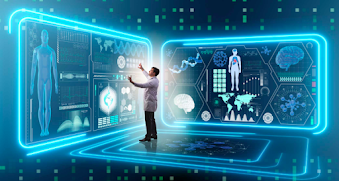Introduction:
In recent years, we have witnessed remarkable advancements in technology that are transforming various industries, and healthcare is no exception. One of the most significant breakthroughs in healthcare technology is the integration of Artificial Intelligence (AI). AI is revolutionizing the way doctors diagnose, treat, and care for patients, leading to improved outcomes and enhanced healthcare experiences. In this blog post, we will explore the ways in which AI empowers doctors and revolutionises healthcare for better patient care.
Medical imaging plays a critical role in diagnosing and monitoring diseases. AI algorithms have the ability to analyze large volumes of medical images, such as X-rays, CT scans, and MRIs, with remarkable precision and speed. By assisting radiologists and pathologists in the interpretation of these images, AI algorithms can detect abnormalities, identify early signs of diseases, and provide more accurate diagnoses. This not only saves time but also improves diagnostic accuracy, leading to better treatment planning and patient outcomes.
Advanced Disease Diagnosis and Prognosis:
AI algorithms have the capability to process and analyze vast amounts of patient data, including medical records, symptoms, lab results, and genetic information. By leveraging this data, AI systems can assist doctors in diagnosing complex diseases and predicting disease progression. These AI-powered tools provide valuable insights, highlight potential treatment options, and support doctors in making more informed decisions, ultimately leading to personalised and targeted treatment plans.
Personalized Medicine and Treatment:
Every patient is unique, and their response to treatments can vary significantly. AI enables doctors to leverage patient data and genetic information to develop personalized treatment plans. By analyzing vast genomic data sets, AI algorithms can identify patterns, predict drug responses, and recommend the most effective medications for individual patients. This approach, known as precision medicine, enhances treatment outcomes, reduces adverse reactions, and improves patient satisfaction.
Virtual Assistants for Efficient Healthcare Delivery:
AI-powered virtual assistants are transforming the way doctors manage their administrative tasks and access medical information. These assistants can quickly retrieve patient data, research papers, drug databases, and treatment guidelines, providing doctors with the information they need at their fingertips. Additionally, virtual assistants can streamline scheduling, appointment reminders, and facilitate communication between healthcare providers. By automating these administrative tasks, doctors can focus more on patient care, leading to improved overall healthcare delivery.
Remote Monitoring and Telemedicine:
In today's digital age, AI-driven remote monitoring systems are becoming increasingly prevalent. These systems allow doctors to remotely monitor patients' vital signs, such as heart rate, blood pressure, and glucose levels, in real-time. AI algorithms can analyze the collected data and alert doctors to any concerning changes, enabling timely interventions and preventing complications. Furthermore, telemedicine platforms powered by AI enable doctors to conduct virtual consultations, providing healthcare access to patients in remote areas and improving overall healthcare accessibility.
Predictive Analytics and Early Warning Systems:
AI has the potential to identify patterns and trends within large datasets, enabling doctors to predict disease outbreaks, monitor public health risks, and detect early signs of potentially life-threatening conditions. By analyzing patient data, AI algorithms can help doctors intervene earlier, improve patient outcomes, and implement preventive measures to safeguard public health. These predictive analytics and early warning systems have the potential to save lives and revolutionize public health strategies.
Conclusion:
Artificial Intelligence is transforming healthcare by empowering doctors with powerful tools and insights to provide better patient care. From advanced medical imaging and diagnosis to personalized treatment plans and remote monitoring, AI is revolutionizing the healthcare industry. It is important to note that while AI can greatly enhance healthcare delivery, it does not replace the expertise and compassion of healthcare professionals. The collaboration between doctors and AI technologies holds immense potential to revolutionize healthcare and ultimately.


















